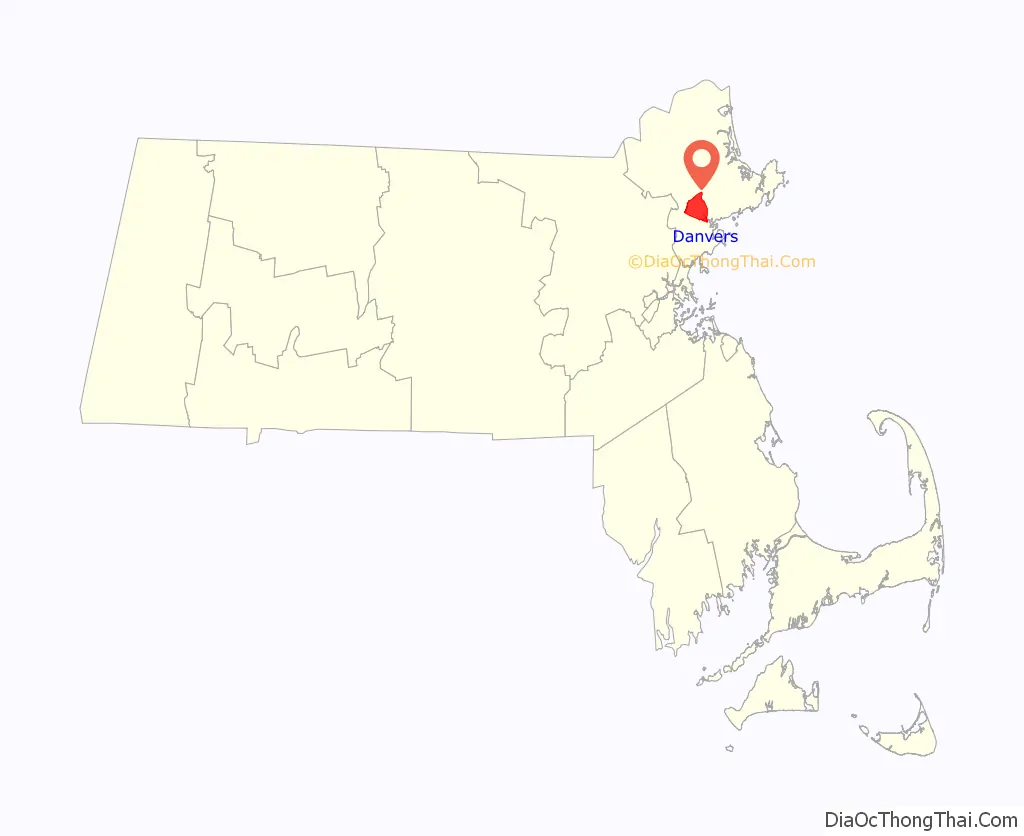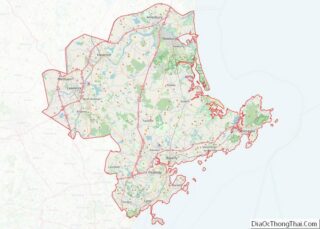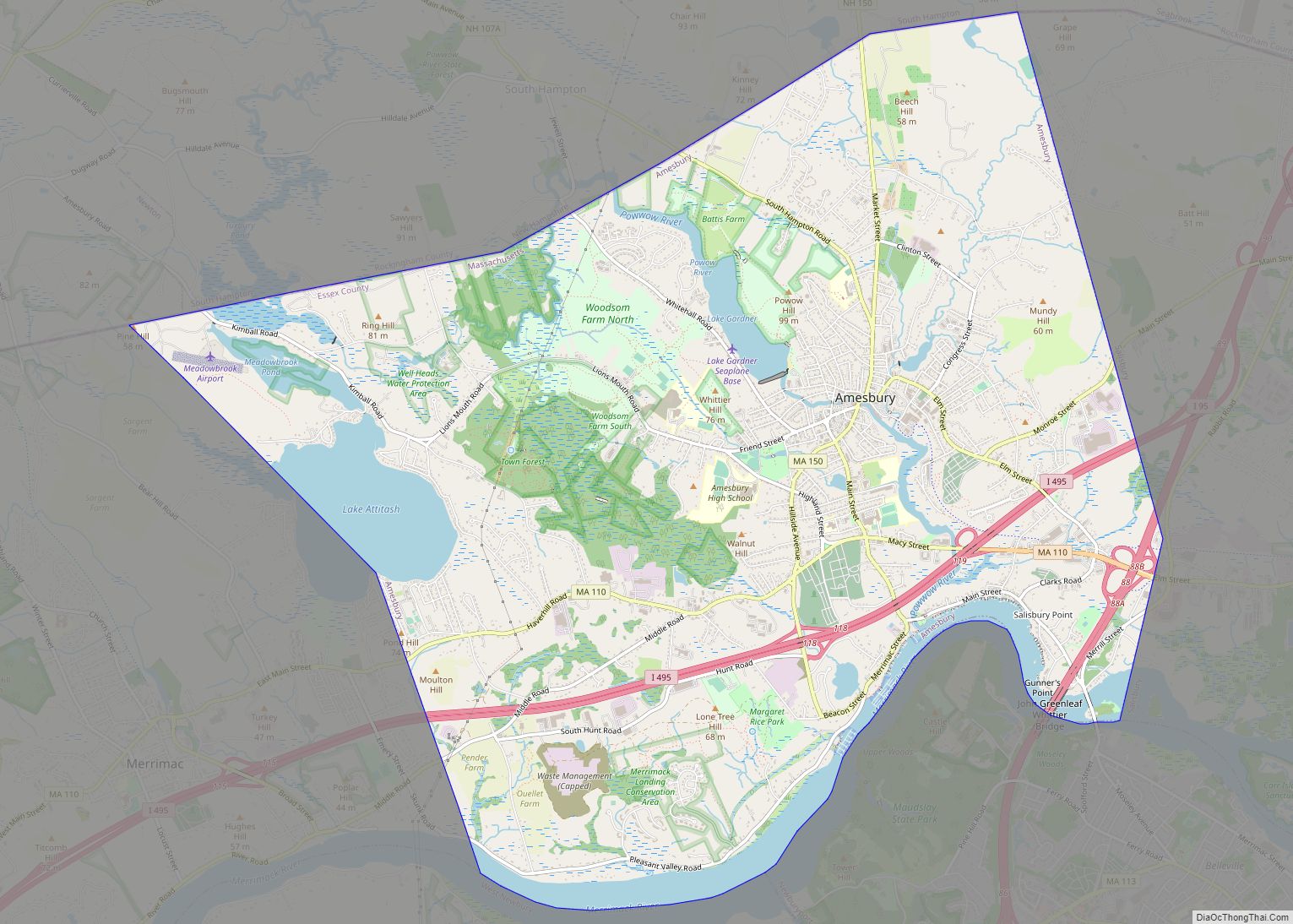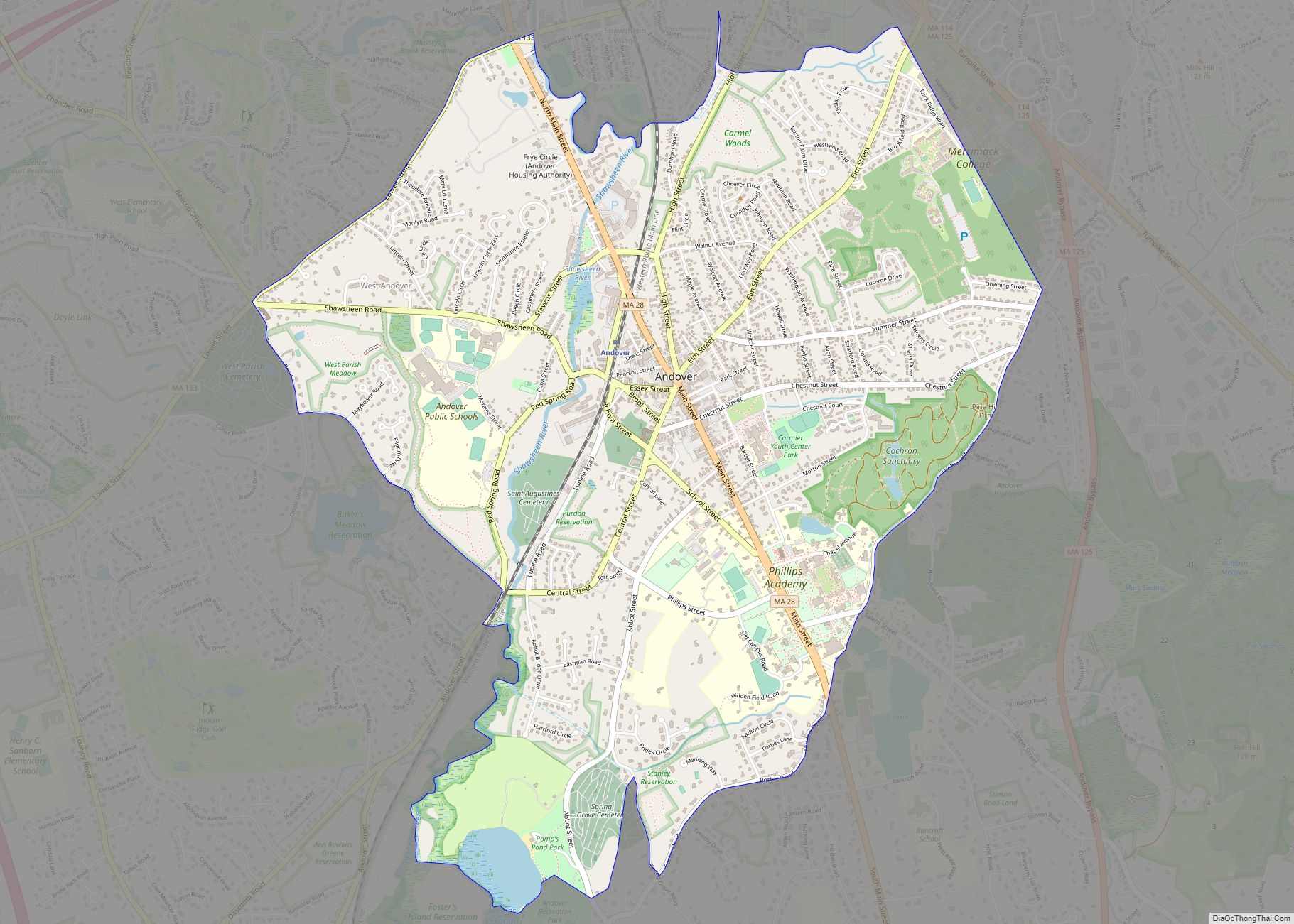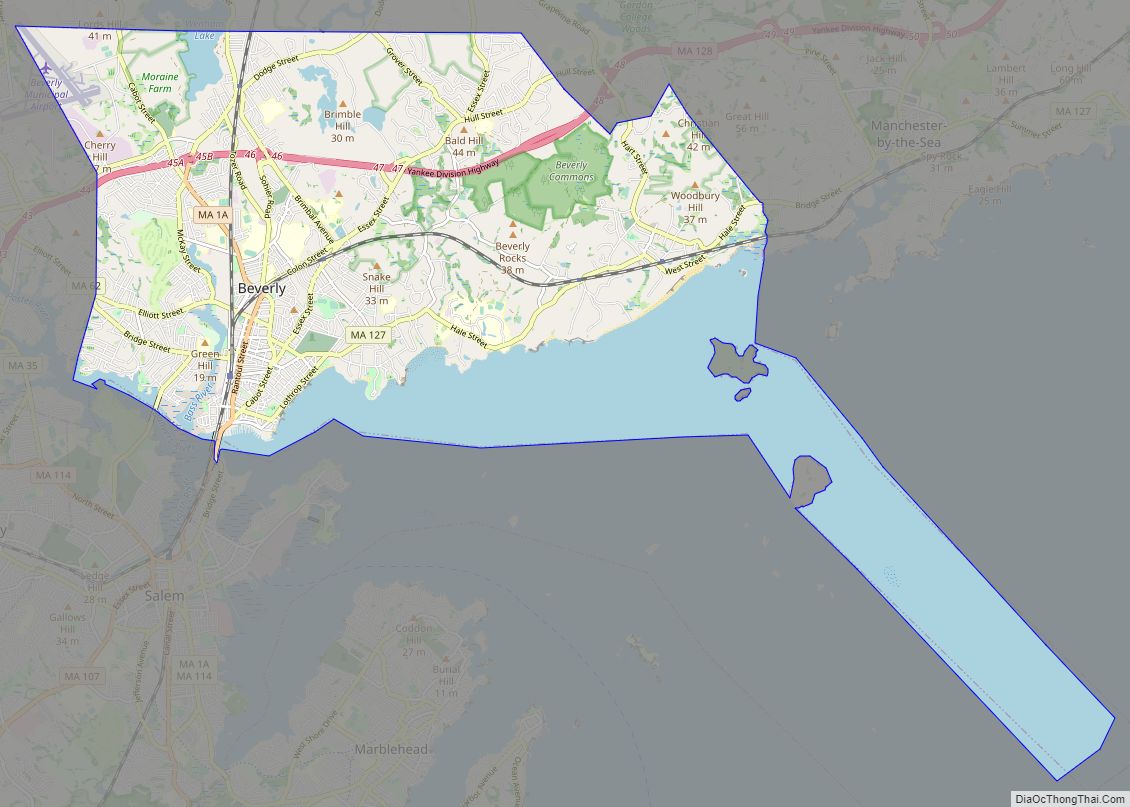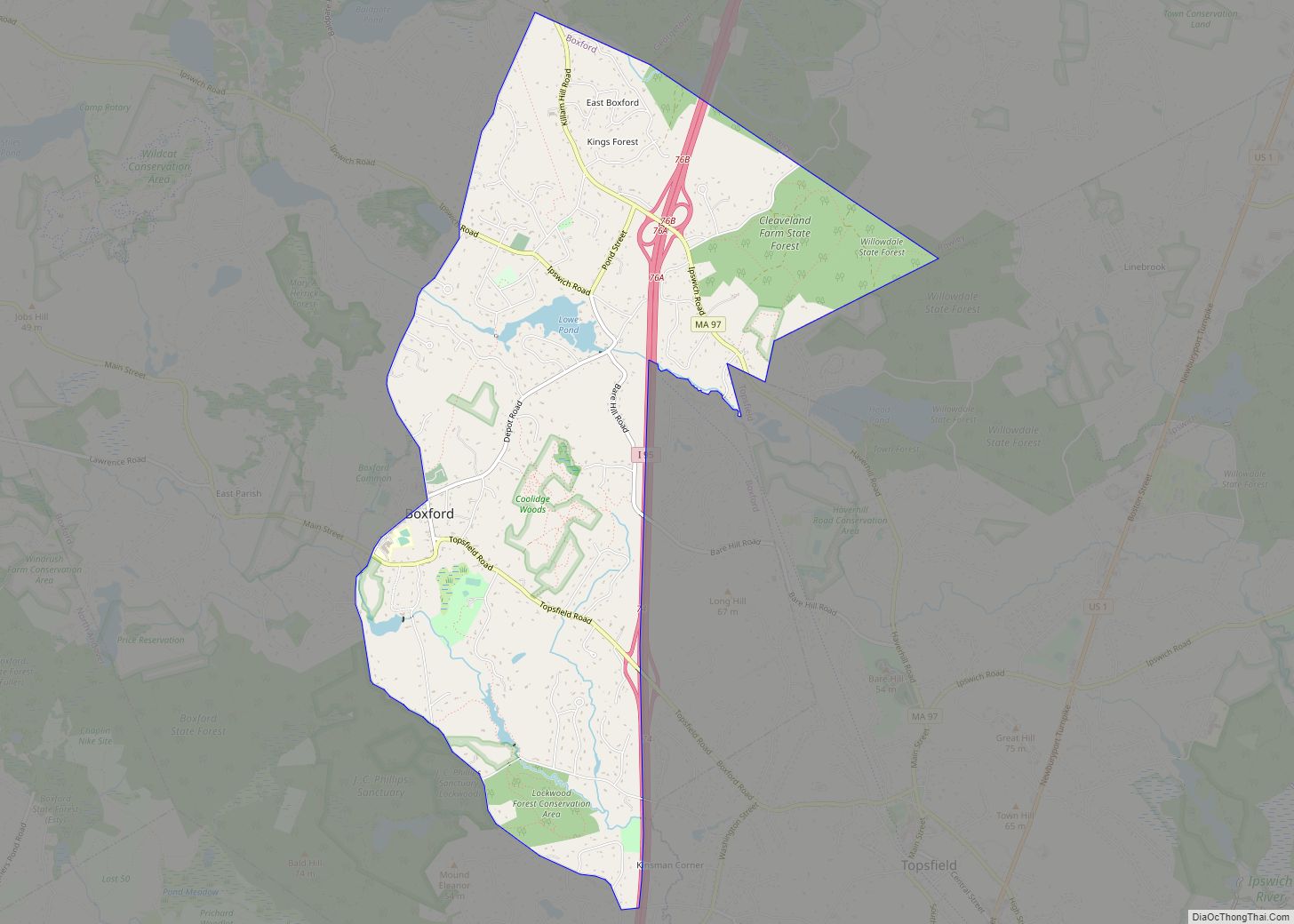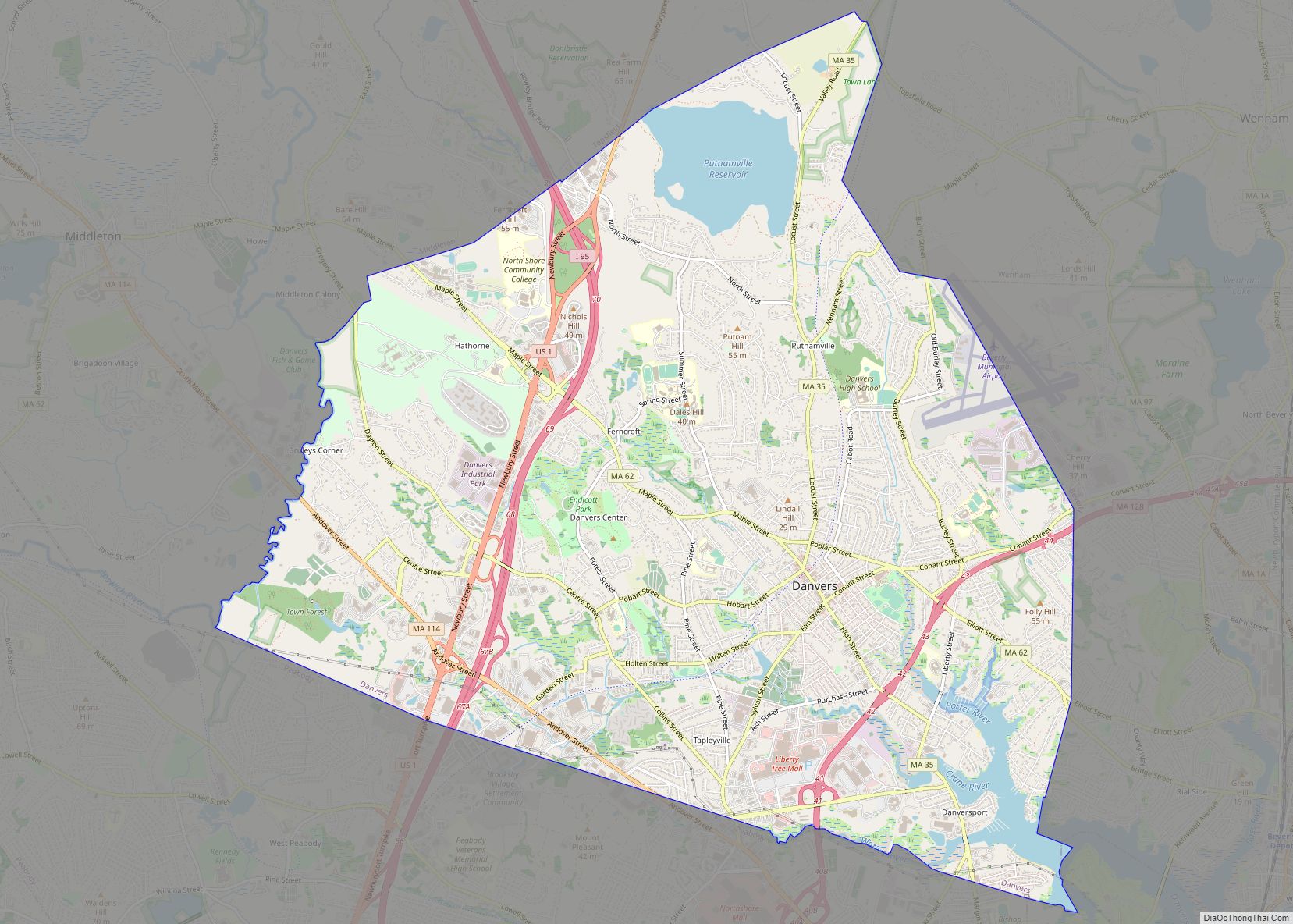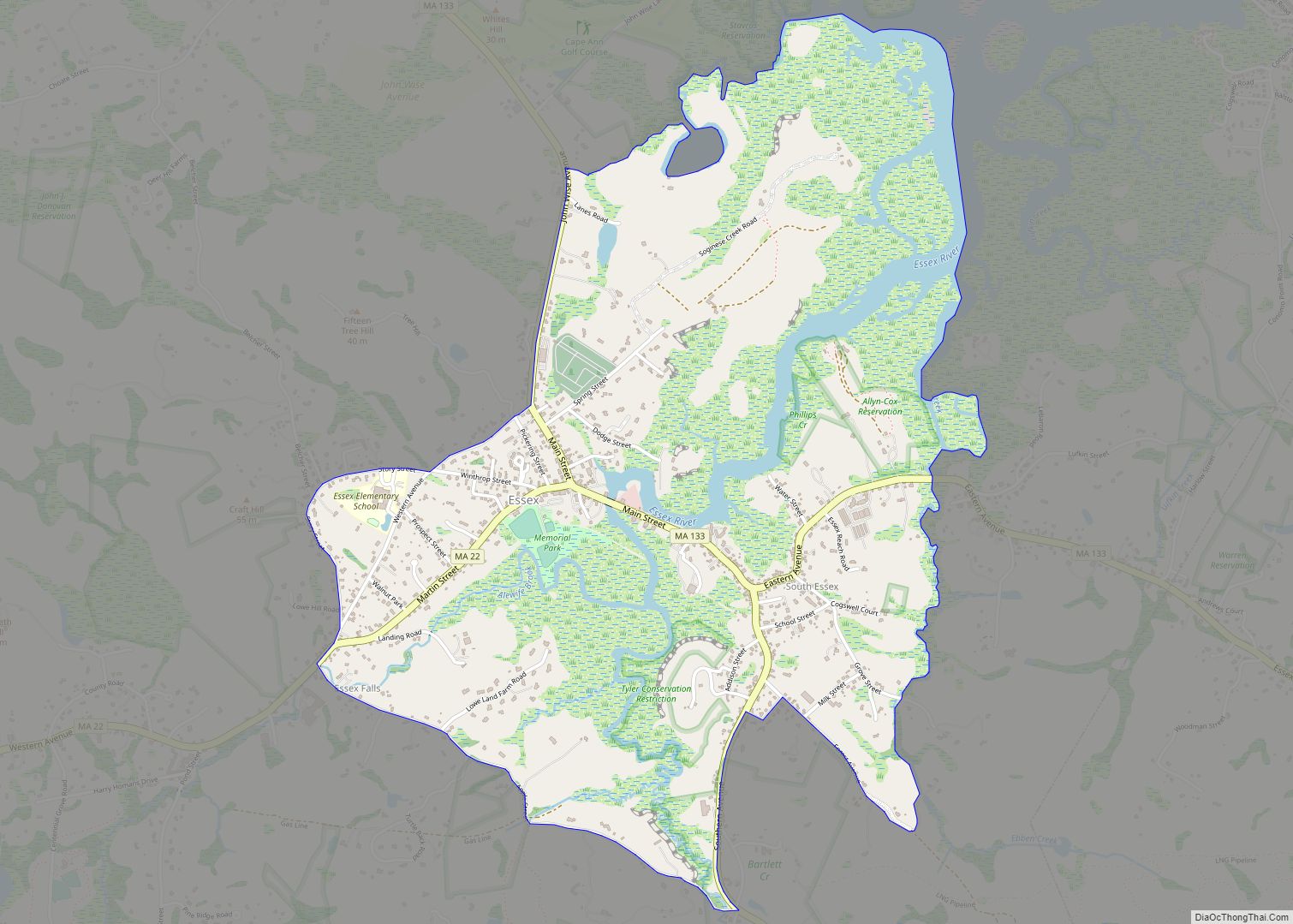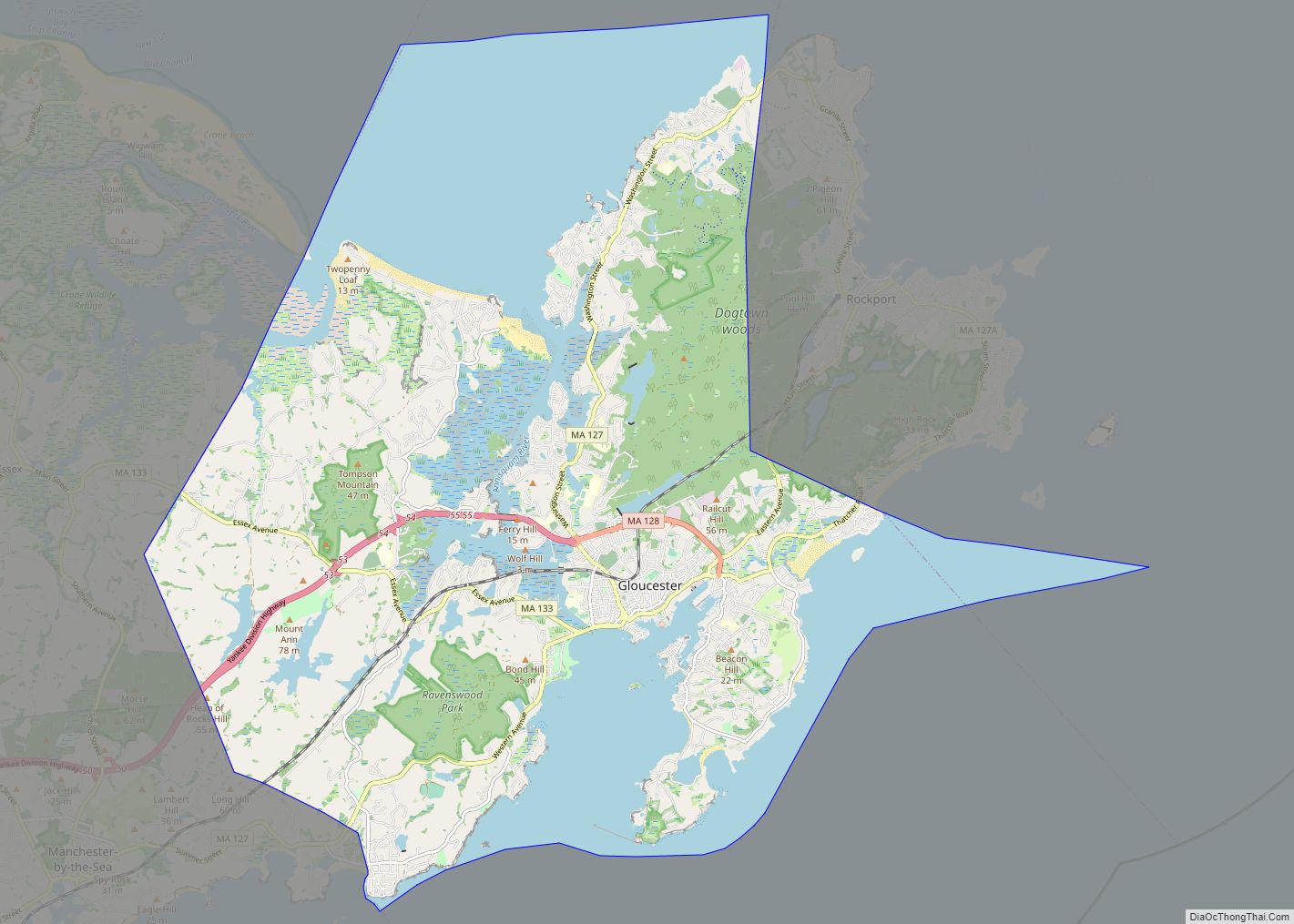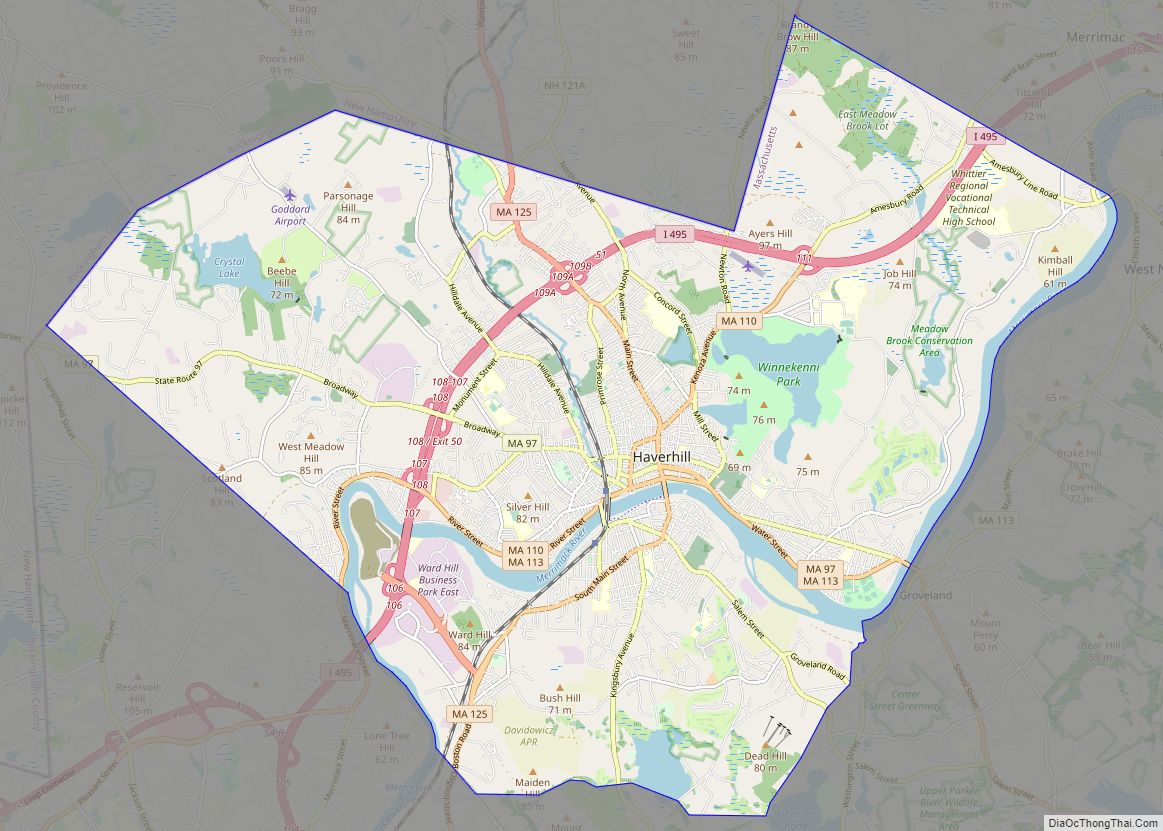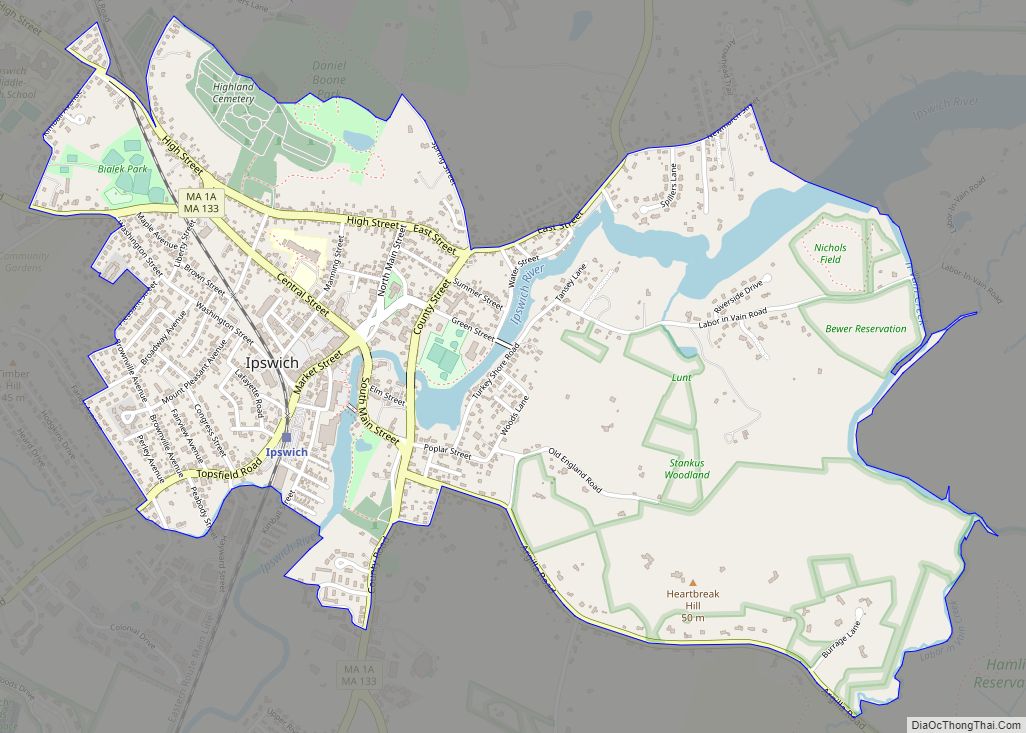Danvers is a town in Essex County, Massachusetts, United States, located on the Danvers River near the northeastern coast of Massachusetts. The suburb is a fairly short ride from Boston and is also in close proximity to the beaches of Gloucester and Revere. Originally known as Salem Village, the town is most widely known for its association with the 1692 Salem witch trials. It was also the site of Danvers State Hospital, one of the state’s 19th-century psychiatric hospitals. Danvers is a local center of commerce, hosting many car dealerships and the Liberty Tree Mall. As of the 2020 United States Census, the town’s population was 28,087.
| Name: | Danvers CDP |
|---|---|
| LSAD Code: | 57 |
| LSAD Description: | CDP (suffix) |
| State: | Massachusetts |
| County: | Essex County |
| Incorporated: | 1757 |
| Elevation: | 48 ft (15 m) |
| Total Area: | 14.1 sq mi (36.5 km²) |
| Land Area: | 13.3 sq mi (34.4 km²) |
| Water Area: | 0.8 sq mi (2.1 km²) |
| Total Population: | 28,087 |
| Population Density: | 2,111.8/sq mi (816.48/km²) |
| ZIP code: | 01923, 01937 (Hathorne) |
| Area code: | 351 / 978 |
| FIPS code: | 2516285 |
| GNISfeature ID: | 0618295 |
Online Interactive Map
Click on ![]() to view map in "full screen" mode.
to view map in "full screen" mode.
Danvers location map. Where is Danvers CDP?
History
Pre-Columbian era
The area was long settled by indigenous cultures of Native Americans. In the historic period, the Massachusett, a tribe of the Pequot language family, dominated the area.
The land that is now Danvers was once owned by the Naumkeag branch of the Massachusett tribe.
Salem Village
Around 1630, English colonists improved an existing Naumkeag trail as the Old Spanish Road, creating a connection to the main cities of Salem and Boston. Danvers was permanently settled in 1636 as Salem Village, and eventually petitioned the Crown for a charter as a town. According to legend, the King, rather than signing the charter, returned it with the message “The King Unwilling.” On June 9, 1757, the town was incorporated regardless, and the King’s rebuff was included on the town’s seal. In 1752, the town was named for settler Danvers Osborn.
The historical event for which Danvers is best-known is the Salem witch trials of 1692. Resident Rebecca Nurse was convicted in a trial for witchcraft. The Rebecca Nurse Homestead is still standing in Danvers, and can be visited as a historical landmark.
18th century
From the Battle of Lexington onward, Danvers residents have participated in the armed forces. Noteworthy Revolutionary figures who stayed in Danvers include Royal Governor General Thomas Gage and Benedict Arnold. Arnold Plaque is found at 1 Conant Street.
Danvers was the birthplace of Israel Putnam, one of the most colorful figures of the colonial period and American Revolution. He built a successful farm, with fruit trees and flocks of sheep, and at one point crawled into a wolf’s den on his hands and knees to kill a wolf that had been eating his sheep. He went into the den’s narrow passage with a torch in one hand, a musket in the other, and a rope tied to his feet leading to his friends outside so they could pull him out if things went wrong. His one shot from the musket got the wolf. He fought with Roger’s Rangers in the French & Indian War. At one point the Indians captured him, had tied him to a tree, and were going to burn him alive. A French officer rescued him in the nick of time.
When the first shots of the American Revolution were fired at the Battle of Lexington and Concord, word reached Putnam on his farm. He literally “came off the plow” to ride off to war again. Without bothering to change his clothes, he mounted his horse and rode the 25 miles to the scene in 18 hours. He was known for his courage, and demonstrated it at the Battle of Bunker Hill, where he is credited with giving the command “Don’t fire until you can see the whites of their eyes.” He became a major general in the Revolutionary War. His birthplace in Danvers, known as the General Israel Putnam House, still stands.
19th century
In 1847, the railroad came to Danvers. A street railway was installed in 1884, originally consisting of 69 horse-drawn trolleys. This system was later converted to electricity.
The Town Hall was built in 1855. It has been modified and renovated and is still in use. Also in 1855, the southern portion of Danvers broke away to become the town of South Danvers, later renamed Peabody.
In 1878, the Danvers State Hospital opened its doors. This was an institution to provide asylum and treatment for the mentally ill.
Originally an agricultural town, Danvers farmers developed two breeds of vegetables: the Danvers Onion (origin of the “Oniontown” nickname) and the Danvers Half-Long Carrot. This carrot was introduced by “market gardeners” in 1871.
Shoe manufacturing was a prominent industry in the late 19th and early 20th centuries. Successful manufacturing companies included Ideal Baby Shoe. Local shoe companies were undercut in price by factories in other areas, and shoe manufacturing moved out.
Films
Movies filmed in Danvers, Massachusetts include:
- Hubie Halloween (2019)
- Ted 2 (2015)
- Crooked Arrows (2012)
- Session 9 (2001)
- Home Before Dark (1958)
Chemical plant explosion
On November 22, 2006, around 2:46 a.m., a major chemical explosion occurred at a facility housing Arnel Company (a manufacturer of industrial-use paint products) and CAI Inc. (a manufacturer of solvents and inks). The blast shook several North Shore towns, knocking homes off foundations and damaging buildings up to half a mile away. Glass windows shattered at least 3 miles (5 km) away, in neighboring Peabody and even in downtown Salem. The explosion was heard and felt up to 45 miles (72 km) away; the concussion was intense.
No one was killed, and none of the injuries were life-threatening, according to Fire Chief Jim Tutko. Approximately 90 homes were damaged. Residents whose homes were damaged or destroyed in the blast were taken to Danvers High School, where the Red Cross established a relief shelter. The blast occurred next to a marina, a bakery/pizza shop, and a gas station, and across the street from Eastern Propane Gas.
A May 13, 2008 report from the U.S. Chemical Safety and Hazard Investigation Board attributed the explosion to unintentional overnight heating of an ink-mixing tank containing flammable solvents.
Danvers Road Map
Danvers city Satellite Map
Geography
According to the United States Census Bureau, Danvers has a total area of 14.1 square miles (37 km), of which 13.3 square miles (34 km) is land and 0.8 square miles (2.1 km), or 5.75%, is water. The tidal Danvers River begins near the southeast corner of town, and is formed by the confluence of the Porter River, Crane River and Waters River. These rivers, in turn, are fed by several brooks. The Ipswich River also flows along the town’s western border. The Putnamville Reservoir lies in the north end of the town, which supplies drinking water to the towns of Salem and Beverly.
Though being at sea level in the Danversport area, the town has numerous hills reaching around 130 to 180 feet in elevation, including Dales Hill (located at St. John’s Preparatory School), Ferncroft Hill, Folly Hill, Hathorne Hill, Lindall Hill, Nichols Hill, Putnam Hill, Rocky Hill and Whipple Hill (part of Endicott Park).
Danvers has numerous villages dating back the late 1800s when the town had a bustling railroad. These include Burley’s Corner, Danvers Center, Danversport, Downtown, Ferncroft, Hathorne (which still has its own post office and ZIP code), Putnamville and Tapleyville.
See also
Map of Massachusetts State and its subdivision: Map of other states:- Alabama
- Alaska
- Arizona
- Arkansas
- California
- Colorado
- Connecticut
- Delaware
- District of Columbia
- Florida
- Georgia
- Hawaii
- Idaho
- Illinois
- Indiana
- Iowa
- Kansas
- Kentucky
- Louisiana
- Maine
- Maryland
- Massachusetts
- Michigan
- Minnesota
- Mississippi
- Missouri
- Montana
- Nebraska
- Nevada
- New Hampshire
- New Jersey
- New Mexico
- New York
- North Carolina
- North Dakota
- Ohio
- Oklahoma
- Oregon
- Pennsylvania
- Rhode Island
- South Carolina
- South Dakota
- Tennessee
- Texas
- Utah
- Vermont
- Virginia
- Washington
- West Virginia
- Wisconsin
- Wyoming

